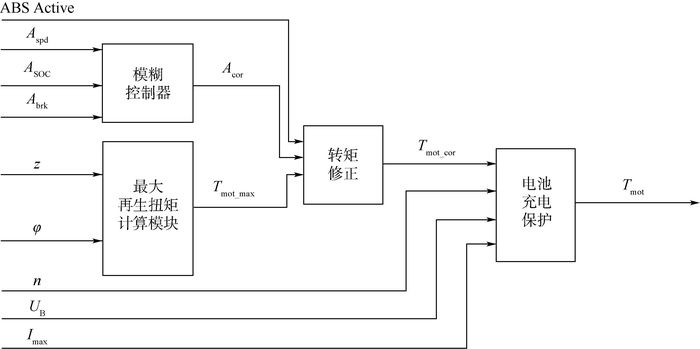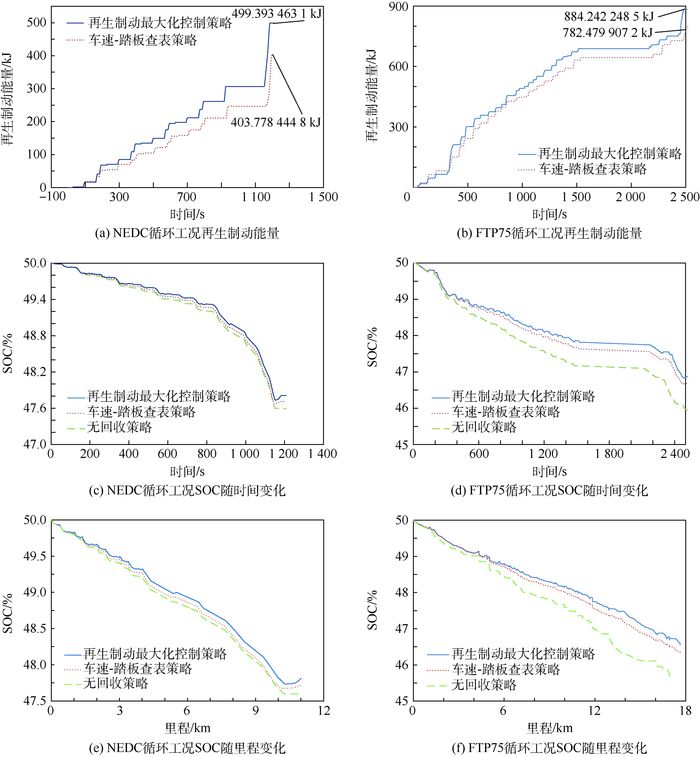-
摘要:
有效的再生制动策略能够增加电动汽车回收能量,提高其续航能力。通过汽车制动动力学以及相关法规的分析,提出了基于边界最大化的再生制动力分配策略,建立了基于制动踏板深度、车速、SOC的模糊制动意图识别模型,识别驾驶员制动意图;建立了基于电机效率曲线的电池充电保护模型,限制电池充电电流。通过对Cruise仿真平台的二次开发,研究本文提出的再生制动策略对于电动汽车续驶里程的影响。在新欧洲行驶循环(NEDC)条件下,该策略能够增加电动汽车续驶里程7.8%;在美国联邦环保局测试工况(FTP75)条件下,该策略能够增加电动汽车续驶里程27.3%。
Abstract:Effective strategy of regenerative brake can increase the recycling energy and improve the driving range of electric vehicles. A recycling brake force distribution strategy on the basis of maximum boundary was proposed from the analysis of the vehicle brake dynamics and related regulations. The models of fuzzy braking intention identification based on brake pedal depth, vehicle speed and SOC wereestablished to identify the driver braking intentions; the models of battery charging protection based on the motor efficiency map were established to limit the battery charging current. The influence of the regenerative brake strategy ondriving range was researched by means of the second development of Cruise simulation platform. The driving range of electric vehicles rises by 7.8% in accordance with the regenerative brake strategy for the new European driving cycle (NEDC). The driving range of electric vehicles rises by 27.3% in accordance with the regenerative brake strategy for the EPA Federal Test Procedure (FTP75).
-
Key words:
- electric vehicle /
- regenerative brake /
- control strategy /
- fuzzy recognition /
- driving range
-
表 1 某纯电动汽车整车参数
Table 1. Parameters of an electric vehicle
参数 数值 整车整备质量Mc/kg 1 700 整车满载质量Mf/kg 2 075 轴距L/mm 2 640 中心到前轴距离La/mm 1 006 风阻系数Cd 0.393 迎风面积A/m2 2.46 车轮滚动半径R/m 0.314 机械传动比im 8.867 传动系统总效率ηt 0.9 电池容量C/(kW·h) 20 电池标称电压Un/V 347.5 最大允许充电电流Imax/A 65 表 2 车速、SOC模糊子集阈值
Table 2. Threshold values for speed and SOC fuzzy subset
车速阈值 SOC阈值 [0, 40) [0, 0.3) [15, 90) [0.2, 0.9) [75, 100] [0.7, 1] 表 3 车速-踏板查表策略
Table 3. TLU strategy of speed-pedal
N·m 车速/
(km·h-1)制动踏板深度/% 0 10 15 20 25 30 40 50 60 80 100 0 0 0 0 0 0 0 0 0 0 0 0 15 0 5 5 5 6 7 7 9 10 10 10 20 0 6 6 6 7 9 9 10 12 12 13 25 0 8 8 8 9 10 10 10 14 15 15 30 0 8 9 9 11 12 14 15 16 18 20 35 0 8 9 10 11 13 15 18 20 23 25 40 0 9 10 11 13 16 19 22 25 29 32 50 0 10 12 14 17 20 23 26 29 32 36 60 0 10 14 17 20 23 27 30 34 37 40 70 0 12 16 19 22 25 29 33 37 41 45 90 0 15 18 21 25 29 32 36 40 46 50 120 0 20 23 26 29 33 37 41 45 50 55 150 0 25 28 31 34 38 42 46 50 55 60 -
[1] NAKAMURA E, SOGA M, SAKAI A, et al.Development of electronically controlled brake system for hybrid vehicle[J].SAE Transactions, 2002, 1(3):471-476. [2] MORITA K.Automotive power source in 21st century[J].JSAE Review, 2003, 24(1):3-7. doi: 10.1016/S0389-4304(02)00250-3 [3] EHSANI M, GAO Y M, EMADI A.Hybrid electric, and fuel cell vehicles fundamentals, theory, and design[M].2nd ed.Chicago:Taylor and Francis, 2012:102-103. [4] 李大伟, 张戎斌, 肖梦.纯电动轿车制动能量回收系统研究[J].机械, 2014, 41(1):36-40. http://www.cnki.com.cn/Article/CJFDTOTAL-MECH201401010.htmLI D W, ZHANG R B, XIAO M.Study on regenerative brake system for pure electric vehicle[J].Machinery, 2014, 41(1):36-40(in Chinese). http://www.cnki.com.cn/Article/CJFDTOTAL-MECH201401010.htm [5] 徐雅楠. 纯电动汽车再生制动控制策略研究和仿真分析[C]//软科学论坛——工程管理与技术应用研讨会, 2015: 11-12.XU Y N.Regenerative braking control strategy research and simulation analysis of electric vehicle[C]//Soft Science Forum-Project Management and Technology Conference Proceedings, 2015:11-12(in Chinese). [6] 宋世欣, 王庆年, 王达.电动轮汽车再生制动系统控制策略[J].吉林大学学报(工学版), 2015, 45(2):341-346. http://www.cnki.com.cn/Article/CJFDTOTAL-BJQC200702004.htmSONG S X, WANG Q N, WANG D.Control strategy for regenerative braking system of in-wheel motor vehicle[J].Journal of Jilin University(Engineering and Technology Edition), 2015, 45(2):341-346(in Chinese). http://www.cnki.com.cn/Article/CJFDTOTAL-BJQC200702004.htm [7] 周苏, 杨国, 任宏伟, 等.基于Cruise的燃料电池增程式电动汽车再生制动转矩分配策略研究[J].汽车技术, 2015(4):46-51. http://www.cnki.com.cn/Article/CJFDTOTAL-QCJS201504012.htmZHOU S, YANG G, REN H W, et al.Research on regenerative braking torque distribution strategies for fuel cell range extended electric vehicle based on Cruise[J].Automobile Technology, 2015(4):46-51(in Chinese). http://www.cnki.com.cn/Article/CJFDTOTAL-QCJS201504012.htm [8] 杨胜兵, 徐锋, 熊晶晶, 等.基于Stateflow的电动汽车再生制动控制策略[J].武汉理工大学学报(信息与管理工程版), 2014, 36(3):301-304. http://www.cnki.com.cn/Article/CJFDTOTAL-WHQC201403002.htmYANG S B, XU F, XIONG J J, et al.Regenerative braking control strategy for electric vehicle based on Stateflow[J].Journal of Wuhan University of Technology(Information & Management Engineering), 2014, 36(3):301-304(in Chinese). http://www.cnki.com.cn/Article/CJFDTOTAL-WHQC201403002.htm [9] 惠登峰.纯电动汽车再生制动控制策略研究[J].汽车实用技术, 2016(5):136-139.HUI D F.Multiplex control strategy for regenerative braking system of pure electric vehicle[J].Automobile Technology, 2016(5):136-139(in Chinese). [10] 余志生.汽车理论[M].北京:机械工业出版社, 2002:142-145.YU Z S.Automobile theory[M].Beijing:China Machine Press, 2002:142-145(in Chinese). [11] 中华人民共和国质量监督检验检疫总局. 商用车辆和挂车制动系统技术要求及试验方法: GB 12676-2014[S]. 北京: 中国标准出版社, 2014.The General Administration of Quality Supervision, Inspection and Quarantine of the People's Republic of China.Technical requirements and testing method for commercial vehicle and trailer braking system:GB 12676-2014[S].Beijing:China Standards Press, 2014(in Chinese). [12] 韩力群.智能控制理论及应用[M].北京:机械工业出版社, 2011:14-58.HAN L Q.Theory and application of intelligent control[M].Beijing:China Machine Press, 2011:14-58(in Chinese). [13] 何莉萍, 李庆锋, 丁舟波, 等.基于模糊神经网络控制的汽车辅助再生制动系统研究[J].湖南大学学报(自然科学版), 2014, 41(10):35-41. http://www.cnki.com.cn/Article/CJFDTOTAL-HNDX201410006.htmHE L P, LI Q F, DING Z B, et al.Research on the vehicle assist regenerative braking system based on the fuzzy neural network[J].Journal of Hunan University (Naturnal Science), 2014, 41(10):35-41(in Chinese). http://www.cnki.com.cn/Article/CJFDTOTAL-HNDX201410006.htm [14] 姬芬竹, 杜发荣, 朱文博.基于制动意图识别的电动汽车能量经济性[J].北京航空航天大学学报, 2016, 42(1):21-27.JI F Z, DU F R, ZHU W B.Electric vehicle energy economy based on braking intention identification[J].Journal of Beijing University of Aeronautics and Astronautics, 2016, 42(1):21-27(in Chinese). [15] 田枫, 刘海洋, 汤盼盼.电动汽车制动能量回收系统研究[J].汽车实用技术, 2015(2):47-50.TIAN F, LIU H Y, TANG P P.Braking energy recovery system for electric vehicle[J].Automobile Technology, 2015(2):47-50(in Chinese). -








 下载:
下载:












